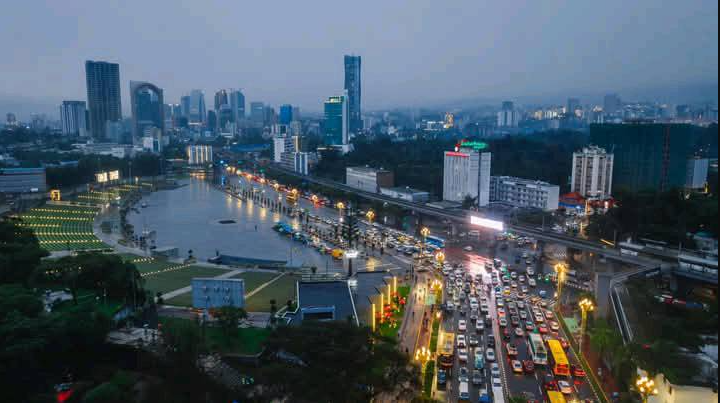When I first thought about visiting Addis Ababa, I pictured a huge, busy city that might be tough to get around. But after spending some time there, I realized it’s actually a pretty cool place, especially if you want to explore on foot. There are so many interesting things to see and do without spending a ton of money. I’m going to share some of my favorite ways to experience this vibrant city, focusing on the Cheapest Ways to Explore Addis Ababa on Foot.
Discovering Addis Ababa’s Cultural Gems
Addis Ababa is more than just a capital city; it’s a treasure trove of Ethiopian culture and history. During my exploration, I made it a point to visit some of the most significant cultural sites, each offering a unique glimpse into the nation’s past and present. It’s amazing how much you can experience just by walking around and taking it all in. I found that free walking tours are a great way to see the city.
Exploring the Ethnographic Museum’s Rich History
The Ethnographic Museum, located on the university campus, was one of my first stops. Housed in a former palace of Haile Selassie, the museum offers an incredible overview of Ethiopia’s diverse cultures and traditions. I spent hours wandering through the exhibits, learning about everything from traditional clothing and musical instruments to religious practices and social structures. The museum is well-organized, and the displays are informative, making it easy to understand the complexities of Ethiopian society. It’s a must-see for anyone interested in learning more about the country’s cultural heritage.
Visiting the National Museum and Lucy’s Exhibit
No trip to Addis Ababa is complete without a visit to the National Museum, home to the famous Lucy exhibit. Seeing the remains of this early hominid was a truly awe-inspiring experience. The museum also houses a collection of artifacts that showcase Ethiopia’s long and rich history, from prehistoric times to the present day. While Lucy is definitely the main attraction, I found the other exhibits to be equally fascinating, providing valuable context for understanding Ethiopia’s place in human history.
Paying Respects at Haile Selassie’s Tomb
The Trinity Cathedral is a beautiful and important religious site in Addis Ababa, and it’s also the final resting place of Emperor Haile Selassie. I found the cathedral to be a peaceful oasis in the middle of the bustling city. The architecture is stunning, with intricate details and beautiful stained-glass windows. Visiting Haile Selassie’s tomb was a somber but meaningful experience, a chance to pay respects to a leader who played a significant role in Ethiopia’s history. The surrounding cemetery is also worth exploring; I even found the grave of Sylvia Pankhurst, the British suffragette. It’s a place of reflection and remembrance, offering a glimpse into Ethiopia’s past and its connections to the wider world.
Navigating Addis Ababa’s Vibrant Districts
Addis Ababa is a sprawling city, and getting to know its different districts is key to experiencing its true character. I found that each area has its own unique vibe and something special to offer. From bustling markets to historical sites, there’s always something new to discover. Just be prepared for some serious hustle and bustle!
Experiencing the Bustle of Piassa Area
Piassa is one of the oldest parts of Addis, and it definitely shows! I loved wandering around here, soaking up the atmosphere. Some of the buildings are really old and creaky, but that’s part of the charm. You can see the Italian influence in some of the architecture, which is pretty interesting. Don’t miss the Taitu Hotel, which was the first modern hotel in Ethiopia and is still operating today. It’s a great place to grab a coffee and people-watch. Getting around Piassa can be a bit chaotic, but that’s part of the fun. I’d recommend using a ride-sharing app if you can, just to avoid any taxi scams.
Uncovering the Merkato’s Expansive Market
The Merkato is supposed to be the biggest market in Africa, and honestly, it feels like it! It’s a total sensory overload, but in a good way. You can find just about anything here, from spices and textiles to electronics and livestock. Each section of the market is dedicated to specific items, so it’s easy to get lost, but that’s part of the adventure. Just be aware of your surroundings and keep your valuables close, as pickpockets are known to operate in the area. I’d also recommend going with a local guide if you can, as they can help you navigate the maze of stalls and haggle for the best prices.
Finding Souvenirs at Shira Market
If the Merkato sounds a bit too intense, Shira Market is a great alternative for souvenir shopping. It’s smaller and more focused on clothing and textiles, so it’s a bit less overwhelming. You’ll find a good selection of traditional Ethiopian dresses, scarves, and other handicrafts here. It’s a bit further out of the city center, near the foot of Entoto Mountain, so you’ll need to take a taxi or ride-sharing service to get there. I found the prices to be a bit higher than at the Merkato, but the quality is generally better, and the atmosphere is more relaxed. Plus, you can enjoy some beautiful views of the city on the way!
Engaging with Local Life and Traditions

Addis Ababa isn’t just about museums and markets; it’s about the people and their way of life. Getting involved with local customs is a great way to experience the city’s true spirit. I found that simply observing daily routines and participating where appropriate offered some of the most rewarding moments of my trip.
Joining Locals for a Jog in Mezscel Square
Mezscel Square isn’t just a landmark; it’s a social hub. Early mornings see many locals exercising in the square. I decided to join them one morning, and it was a fantastic experience. The energy was infectious, and it was a great way to start the day. It’s a simple, free way to feel like you’re part of the community. Just be mindful of your belongings, as crowded areas can attract unwanted attention.
Witnessing Devotion at St George’s Church
Religion plays a big role in Ethiopian life, and St. George’s Church is a significant place of worship. Even if you’re not religious, witnessing a service can be a powerful experience. The vibrant colors, the chanting, and the sheer devotion are something to behold. Remember to dress respectfully (shoulders and knees covered) and be mindful of the worshippers. I found it incredibly moving to witness such faith firsthand.
Enjoying Traditional Ethiopian Dining and Entertainment
Food is a huge part of any culture, and Ethiopian cuisine is no exception. Forget fancy restaurants; head to a local eatery and try some injera with various wats (stews). Sharing a meal is a communal experience, and you’ll often find yourself chatting with locals. For entertainment, check out a cultural show with traditional music and dance. I went to one place where they had live music and dancers, and it was a blast. It’s a great way to immerse yourself in the local culture and have some fun. Fendika is a great place to experience Ethiopian culture through music and art.
Exploring Addis Ababa’s Historical Narratives
Addis Ababa is more than just a bustling city; it’s a living history book. As I walked its streets, I felt like I was stepping back in time, encountering stories etched into every building and monument. It’s amazing how much history is packed into this one city!
Understanding the Red Terror Museum’s Impact
The Red Terror Museum is a sobering experience, but an important one. It documents a dark period in Ethiopia’s history, and seeing the exhibits really brought home the scale of the tragedy. It’s a place for reflection and remembrance, and I think it’s essential to understand the Red Terror to truly appreciate modern Ethiopia. It’s not an easy visit, but it’s a necessary one.
Delving into Trinity Cathedral’s Significance
Trinity Cathedral is stunning. The architecture is incredible, and the sheer scale of the place is awe-inspiring. It’s not just a beautiful building, though; it’s also the final resting place of Emperor Haile Selassie. I spent a good amount of time wandering around, taking in the history and the art. The stained glass windows are particularly impressive. It’s definitely a must-see if you’re interested in Ethiopian history and religious art. The Trinity Cathedral’s significance is undeniable.
Tracing Italian Influence in City Architecture
It’s easy to spot the Italian influence on Addis Ababa’s architecture. From the Piassa area to certain government buildings, the Italian style is evident. It’s a reminder of a brief but impactful period in the city’s history. I found it fascinating to compare the Italian-designed buildings with the more traditional Ethiopian structures. It’s a unique blend of styles that gives Addis Ababa a distinct character. The city architecture is a testament to this blend.
Affordable Adventures Beyond the City Center

Addis Ababa is great, but sometimes you just need to get out of the city, you know? Luckily, there are some pretty cool and affordable options for day trips. I’ve found that these trips offer a different perspective on Ethiopia, and they don’t have to break the bank.
Taking a Day Trip to Entoto Mountain
Entoto Mountain is a classic choice, and for good reason. It’s super close to Addis, so the travel time isn’t too bad. I usually grab a minibus or share a taxi with some friends to keep costs down. The ride itself is an experience, winding up the mountain with views getting better and better. Pack some snacks and water, because options are limited once you’re up there.
Enjoying Panoramic Views from Entoto
Okay, the views from Entoto are seriously amazing. You can see the whole of Addis Ababa spread out below you, which is especially cool if you go on a clear day. I like to find a quiet spot, sit down, and just take it all in. It’s a great place to get some perspective and appreciate the scale of the city. Plus, it’s totally free to just wander around and enjoy the scenery.
Discovering Churches on Entoto Mountain
Entoto isn’t just about the views; there are also some really interesting old churches up there. I’m not super religious, but I always find these places fascinating. They’re often decorated with colorful paintings and have a really unique atmosphere. There’s usually a small entrance fee, but it’s worth it to see the inside and learn a bit about their history. I recommend checking out St. Maryam Church; it’s one of the most well-known and has some beautiful artwork.
Practical Tips for Exploring Addis Ababa
Utilizing Ride-Sharing for Cost-Effective Travel
I’ve found that getting around Addis Ababa doesn’t have to break the bank. While Uber isn’t available, a local app called “Ride” is a game-changer. It’s only on Android right now, but it’s worth downloading if you can. It’s way better than haggling with taxis all the time, and you know you’re getting a fair price. Plus, it’s super convenient when you’re tired after a long day of exploring. I’ve used it to get from the airport to my hotel and to visit different parts of the city. It’s definitely saved me some serious cash.
Navigating Public Transport Options
Okay, so the public transport in Addis Ababa can seem a little intimidating at first, but it’s actually pretty doable once you get the hang of it. There’s a bus service and a metro, but honestly, I usually stick to the buses. They’re super cheap, like ridiculously cheap. Just be prepared for them to be crowded, especially during rush hour. It’s a great way to experience local life, though! I usually ask someone at my hotel to help me figure out which bus to take, and they’re always happy to help. It’s an adventure, that’s for sure!
Prioritizing Safety While Exploring
Okay, let’s talk safety. Addis Ababa is generally safe, but it’s always good to be aware of your surroundings. I’ve heard stories about pickpockets, especially in crowded areas like the Merkato market. So, I always keep my valuables close and avoid flashing expensive stuff around. I also try not to walk alone at night, especially in areas that aren’t well-lit. If I’m going somewhere far, I prefer to use the Ride app or a registered taxi. It’s better to be safe than sorry, right? And remember, trust your gut. If a situation feels off, just remove yourself from it. I also found that solo female travelers should be extra cautious and consider using local guides in rural areas.
Wrapping Things Up
So, there you have it. My time walking around Addis Ababa really opened my eyes. I mean, sure, it’s a big city, and it can feel a bit much at first. But honestly, once you get past that, there’s so much to see and do just by putting one foot in front of the other. I found some cool spots, met some nice people, and even though I had to be careful with my phone, I never felt truly unsafe during the day. It just goes to show, sometimes the best way to get to know a place, especially one like Addis, is to just walk it. You see things you’d miss from a car, and you get a real feel for the city’s vibe. I’m glad I took the time to explore it this way, and I think you will be too.
Frequently Asked Questions
How do I get to Addis Ababa?
Most people fly into Ethiopia through its main airport in Addis Ababa. I always check Skyscanner to find the best flight deals. The airport is pretty close to the city center, so a short taxi ride will get you to where most travelers stay. A taxi should cost less than $10 USD. For more tips on money and visas for Ethiopia, check out my other articles.
When is the best time to visit and how long should I stay?
I definitely think you should visit Addis Ababa and northern Ethiopia during the dry season, which is usually from December to April. You can see most of Addis’s cool spots in one day, but if you want to really get to know the city and see some nearby places, I suggest staying for a couple of days. You won’t regret it!
What’s the best way to get around Addis Ababa?
Addis has buses and a metro, but I find taxis the easiest way to get around, even though I’m usually a budget traveler! There’s no Uber, but a new app called ‘Ride’ is available on Android. The blue cars are taxis, and you can usually get a good price if you bargain. Just be careful, as I’ve heard from other travelers that street muggings have become more common recently. Don’t keep your phone in your pockets and avoid walking alone at night.
Where can I find more travel tips for Ethiopia?
I’ve put together a special guide just for traveling in Ethiopia. It has all my best tips for exploring this amazing country in one easy-to-read eBook. It includes 11 full guides to the best cities and attractions.
Are there any good tours in Ethiopia?
If you’re looking for a great, affordable tour in Ethiopia with guides you can trust, just send me an email with where you want to go, and I’ll share my top recommendations. You can also check out some other good options online that cover Addis Ababa and beyond.
What are 5 essential things I should pack for Ethiopia?
Here are five things I think you really need for your trip to Ethiopia: a headlamp (for when the power goes out), toilet paper (most places don’t have it), long, thin pants (for cool evenings and respectful dress), and a good camera (to capture the amazing sights).






